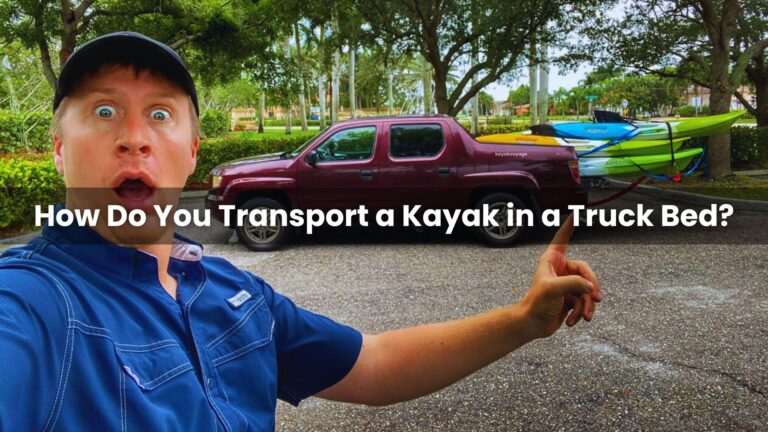When it comes to outdoor adventures, kayaking stands out as a favorite for many. Before you can enjoy the tranquility of the water, you must tackle the challenge of transportation. How do you transport a kayak in a truck bed is a question that arises for truck owners who wish to venture into kayaking. The answer lies in the methodical and secure placement of the kayak in the truck bed, ensuring it’s ready for action upon arrival.
This article will provide details on the best practices for transporting a kayak in a truck bed. We’ll explore the significance of proper transport techniques to maintain the integrity of your kayak and guarantee a hassle-free start to your aquatic excursion. By adhering to the advice provided here, you’ll be well-equipped to transport your kayak safely, allowing you to focus on the excitement of the paddle rather than the worry of the journey.
Preparing Your Truck Bed for Kayak Transport
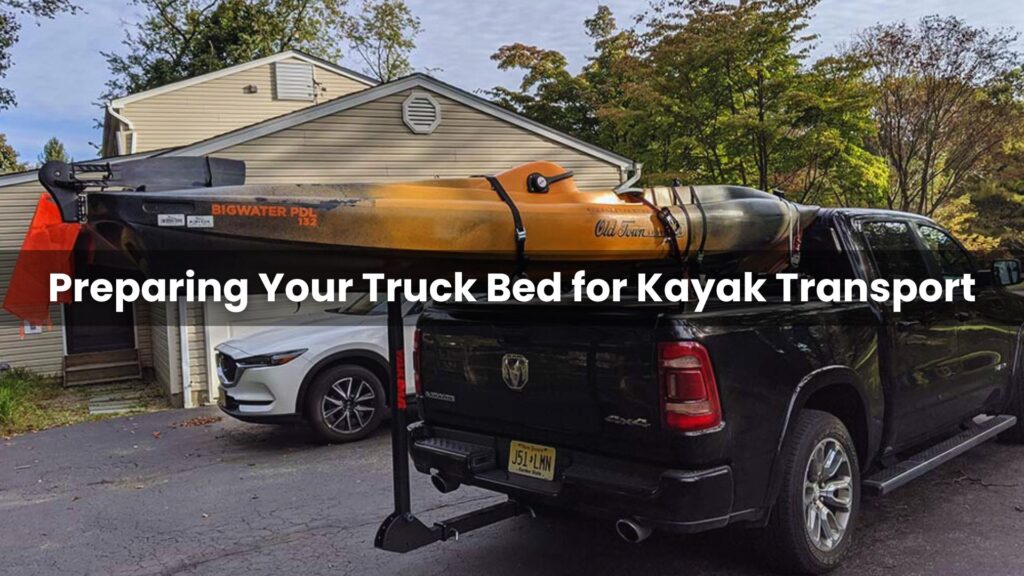
Before you place your kayak in the truck bed, it’s crucial to have the right equipment on hand to secure it properly. Here’s a list of essential items you’ll need, along with an explanation of each item’s purpose:
Kayak Straps: These are specialized straps designed to hold your kayak firmly in place. They are typically made of durable materials with cam buckles or ratcheting mechanisms to adjust the tension.
Tie-Downs: In addition to kayak straps, tie-downs are used to secure the kayak’s bow and stern to the truck. They provide extra stability and ensure that the kayak doesn’t shift during transport.
Padding: Padding serves as a protective layer between the kayak and the truck bed. It can be in the form of foam blocks or a specialized kayak pad. This prevents scratches and dents on both the kayak and the truck bed.
Truck Bed Mat: A truck bed mat provides a non-slip surface that keeps the kayak from sliding. It also protects the bed from damage and reduces noise from vibration during travel.
How to Choose the Right Kayak Straps and Tie-Downs?
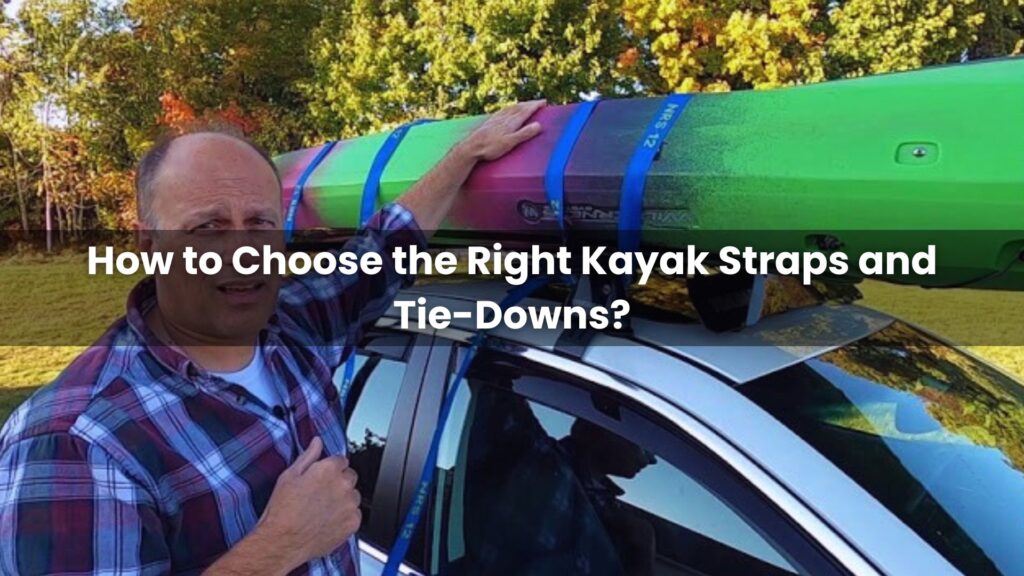
When preparing to transport your kayak in a truck bed, selecting the right straps and tie-downs is crucial for ensuring the safety of your kayak and other road users. Here’s what you need to consider:
Material: Look for straps made from durable, high-quality materials such as polypropylene or nylon. These materials are resistant to abrasion and less likely to wear down over time, which is essential for the security of your kayak during transport.
Length: The length of your straps should be appropriate for the size of your kayak and truck bed. Typically, straps that are 12 to 15 feet long will suffice for most single kayaks. If you have a larger kayak or plan to transport multiple kayaks, consider longer straps that can accommodate the extra size and weight.
Adjustability: Straps with a cam buckle or ratchet system offer the best adjustability and security. Cam buckles are ideal for quick and easy tightening and releasing, while ratchet straps provide a more secure fit for heavier kayaks.
Recommendations for Different Types of Kayaks and Truck Beds
Recreational Kayaks: For lighter, smaller kayaks, cam buckle straps are usually sufficient. Ensure the straps are snug but not overly tight to prevent damage to the kayak’s hull.
Touring and Sea Kayaks: These longer and often heavier kayaks benefit from ratchet straps that can handle the extra weight without stretching.
Truck Beds with Rails: If your truck bed has rails, you can use them to your advantage by looping the straps around the rails for added security.
Truck Beds without Rails: In this case, consider using anchor points installed in the truck bed or tailgate to secure the straps.
Securing the Kayak in the Truck Bed
Once you have prepared your truck bed and chosen the right straps and tie-downs, it is time to secure the kayak. Here are the steps to follow:
Position the Kayak: Position the kayak in the truck bed, making sure it is centered and balanced.
Strap the Kayak: Use the kayak straps to secure the kayak to the truck bed. Make sure the straps are tight and evenly distributed.
Tie Down the Kayak: Use the tie-downs to tie down the kayak to the truck bed. Make sure the tie-downs are tight and secure.
Add Padding: Add padding to protect the kayak and the truck bed from damage during transport.
How to Use Kayak Straps and Tie-Downs for Secure Transport?
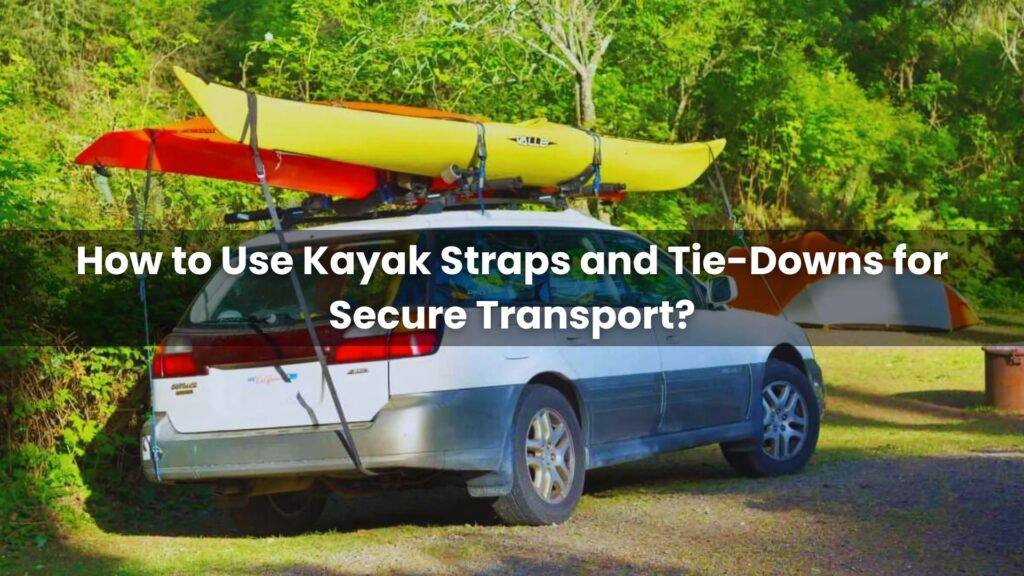
Transporting a kayak in a truck bed requires careful strapping and tying down to ensure it remains secure throughout the journey. Here’s a detailed guide to help you safely transport your kayak:
Step-by-Step Guide on How to Strap and Tie Down the Kayak:
Position the Kayak: Place the kayak in the truck bed with the hull facing up to prevent deformation. If the kayak extends beyond the truck bed, use a bed extender for support.
Use Cam Straps: Lay two cam straps over the kayak’s hull, positioning them at the front and back of the cockpit. These are the strongest points and will provide the most stability.
Thread the Straps: Pass the straps through the kayak’s scupper holes or around the thwarts if it’s a sit-inside kayak. Ensure the buckle part of the strap is on top for easy access.
Secure to Anchor Points: Hook the straps to the truck bed’s anchor points or tie-down loops. If your truck doesn’t have these, you can install aftermarket anchors or use the truck’s bed rails.
Tighten the Straps: Pull the free end of the strap to tighten it around the kayak. The tension should be firm but not so tight that it deforms the hull.
Tips for Adjusting and Tightening the Straps and Tie-Downs:
Check for Movement: After tightening, gently rock the kayak to check for any movement. If it shifts, tighten the straps further.
Protect the Kayak: Use foam blocks or padding under the straps to protect the kayak’s surface from scratches and pressure points.
Avoid Twisting Straps: Ensure the straps lay flat against the kayak and truck bed to prevent them from catching wind and loosening during transport.
Use Bow and Stern Lines: For additional security, attach bow and stern lines from the kayak’s ends to the truck’s towing hooks or bumper. This prevents the kayak from shifting forward or backward.
Regular Checks: During long trips, stop periodically to check the tightness of the straps and adjust if necessary.
Tips for Safe and Secure Kayak Transport
Transporting a kayak in a truck bed can be a straightforward process if done correctly. Ensuring the safety and security of your kayak during transport is paramount. Here are some expert tips to help you transport your kayak without any hiccups:
Use the Right Equipment: Invest in quality tie-down straps, cam straps, or ratchet straps to secure the kayak. Avoid using bungee cords as they can stretch and allow the kayak to move.
Positioning the Kayak: Place the kayak in the truck bed with the cockpit facing up to prevent warping. If the kayak extends beyond the truck bed, use a bed extender for better support.
Securing the Kayak:
At the Front: Attach the straps through the kayak’s front grab handle and secure them to the truck’s towing hooks or bed anchors.
At the Back: Use the rear grab handle to tie the kayak down to the truck bed’s anchor points or to the bed extender if you’re using one.
Check for Movement: After securing the kayak, give it a gentle shake to ensure there is no movement. If the kayak shifts, tighten the straps accordingly.
Red Flag: If the kayak extends over the truck bed by more than a few feet, attach a red flag to the end of the kayak to alert other drivers.
Regular Checks: During transport, make periodic stops to check the kayak’s security, especially if you’re traveling a long distance.
How to Prevent Damage to Your Truck Bed and Kayak?
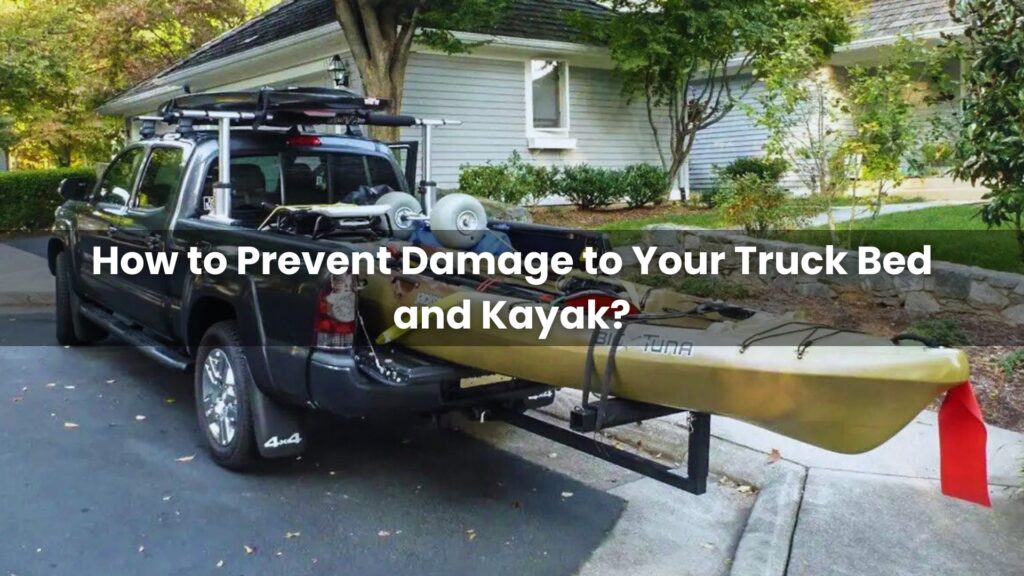
When transporting a kayak in a truck bed, it’s essential to protect both your vehicle and your kayak from damage. Here are some expert strategies to ensure that both remain in pristine condition during transit:
Use Protective Padding: Place non-slip mats or rubberized liners in the truck bed to prevent the kayak from sliding and scratching the bed. Foam blocks or pool noodles can be used as cushioning between the kayak and the truck bed sides.
Proper Loading Technique: Lift the kayak carefully into the truck bed to avoid scraping the tailgate or sides. It’s best to have a second person help with loading and unloading to distribute the weight evenly.
Avoid Over-Tightening Straps: While securing the kayak is crucial, over-tightening the straps can cause dents to the truck bed and deform the kayak’s hull. Tighten the straps just enough to hold the kayak firmly in place.
Kayak Positioning: If possible, position the kayak so that it rests on its strongest points, typically the side rails or scupper holes, to distribute the pressure evenly.
Weather Considerations: If transporting in hot weather, be mindful that the heat can soften the kayak’s plastic, making it more susceptible to damage. In such cases, extra padding and less tension on the straps can prevent warping.
Regular Inspection: Regularly inspect both the kayak and the truck bed for any signs of wear and tear. Address any issues promptly to prevent further damage.
Importance of Padding and Protecting the Kayak and Truck Bed
Ensuring that your kayak and truck bed are well-protected is a critical aspect of transporting a kayak. Proper padding serves multiple purposes it cushions the kayak, preventing scratches and dents; it reduces the risk of the kayak slipping during transport; and it protects the truck bed from damage. Here’s how to effectively pad and protect your kayak and truck bed:
Selecting the Right Padding: Use specialized kayak pads or non-slip mats designed for truck beds. These materials are durable and provide a secure base for your kayak.
Placement of Padding: Position the padding to cover all points of contact between the kayak and the truck bed. Ensure that the sides of the kayak are also protected if they rest against the bed’s sides.
Securing the Kayak: After placing the kayak on the padding, use straps to secure it firmly in place. The padding should not compress too much; otherwise, it won’t provide adequate protection.
Protecting the Truck Bed: Consider adding a truck bed liner or a protective coating to the bed if you frequently transport kayaks or other gear. This will provide a permanent protective layer against scratches and dents.
Regular Maintenance: Inspect and replace padding as needed. Worn-out or damaged padding won’t offer the same level of protection and could lead to damage over time.
What to Do in Case of Inclement Weather or Road Conditions?

Transporting a kayak in a truck bed during inclement weather or challenging road conditions requires extra precautions to ensure the safety of both the kayak and other road users. Here are some expert tips to navigate these situations:
Weatherproofing Your Kayak: If you’re expecting rain, snow, or heavy winds, cover your kayak with a waterproof tarp or specially designed kayak cover. Secure the cover with additional straps to prevent it from flapping or coming loose.
Visibility is Key: In poor weather conditions, visibility can be significantly reduced. Use reflective tape or additional lighting on the back of your kayak to make it more visible to other drivers.
Adjust Your Driving: Slow down and increase your following distance. Sudden stops or sharp turns can cause the kayak to shift, even if it’s well-secured.
Road Condition Awareness: Be aware of road conditions that could affect your transport. Potholes, gravel, or uneven roads can jostle the kayak. Drive carefully to avoid any sudden jolts.
Secure Against Wind: Crosswinds can be particularly problematic. Make sure your kayak is secured from multiple angles to prevent it from acting like a sail.
Emergency Preparedness: Keep an emergency kit in your truck, including extra straps, tools for quick adjustments, and contact information for roadside assistance.
Tips for Securing the Kayak in Windy or Rainy Conditions
Transporting a kayak in a truck bed can be challenging, especially when the weather is not on your side. Wind and rain can pose significant risks if the kayak is not secured properly. Here’s how to ensure your kayak remains safe and secure:
Use Cam Straps: Cam straps are ideal for securing kayaks because they can be easily tightened and provide a strong hold. Make sure to use at least two straps, one at the front and one at the back of the kayak.
Bow and Stern Lines: Attach lines to the bow and stern of the kayak and then to your truck’s towing hooks. This will prevent the kayak from shifting or lifting in high winds.
Cockpit Covers: If you’re expecting rain, use a cockpit cover to prevent water from filling the kayak. This will keep it lighter and more manageable.
Padding: Place non-slip padding under the kayak to prevent it from sliding around in the truck bed. Rubber mats or even a wet towel can provide good traction.
Check the Forecast: Before setting out, check the weather forecast. If high winds or severe weather are expected, consider postponing your trip.
Regular Checks: On long journeys, stop regularly to check that the kayak is still securely fastened. Windy conditions can loosen straps over time.
Conclusion
In conclusion, transporting a kayak in a truck bed requires careful planning and execution to ensure safety and prevent damage. By using the right equipment such as cam straps, bow and stern lines, and cockpit covers, you can secure your kayak against the unpredictable challenges posed by windy and rainy conditions. Padding under the kayak can prevent slippage, and regular checks will help you maintain the security of the setup throughout your journey.
FAQs and Troubleshooting Common Issues
When it comes to transporting a kayak in a truck bed, several common questions and issues may arise. Here are some frequently asked questions with their solutions and tips for a smooth transport experience:
How Do I Secure a Kayak in a Truck Bed?
Use tie-downs and ropes to secure the kayak in the truck bed. This ensures the kayak stays in place during transport and prevents damage to the vehicle or the kayak.
How Do I Prevent the Kayak from Sliding in the Truck Bed?
Use bow and stern tie-downs to prevent the kayak from sliding during transport. These tie-downs help keep the kayak stable and secure.
How Do I Ensure the Kayak is Properly Loaded in the Truck Bed?
Ensure the kayak is properly loaded in the truck bed by checking its position and securing it with tie-downs and ropes. This prevents the kayak from shifting during transport.
How Do I Prevent Damage to the Truck Bed or the Kayak?
Use soft roof racks or other protective gear to prevent damage to the truck bed or the kayak during transport. These racks help distribute the weight of the kayak evenly and reduce the risk of damage.
How Do I Transport a Heavy Kayak in a Truck Bed?
If you have a heavy kayak, consider using a trailer for transport. Trailers provide a more stable and secure way to transport heavy kayaks, reducing the physical strain of lifting and securing the kayak.
How Do I Ensure the Kayak is Properly Secured During Transport?
Regularly check the securing system to ensure everything is properly fastened. This includes checking the tie-downs, ropes, and any other securing mechanisms to prevent the kayak from shifting or becoming loose during transport.

Nigel Foster, born in 1952, is an esteemed sea kayaker, known for being the youngest to kayak around Iceland. His journey in kayaking started at 15 in Brighton, England. With a career beginning as a trainee instructor in Sussex, he later pursued teaching after attending Redland College, Bristol.
Foster’s notable expeditions include navigating the challenging waters of Newfoundland and the Hudson Strait. Despite facing intense conditions, his passion for kayaking never waned. He holds several British Canoe Union qualifications and has significantly contributed to the kayaking community through teaching and committee work.
In 1985, Foster expanded his horizons by assisting an expedition in Iceland and later founded his own kayaking business, sharing his expertise globally.
